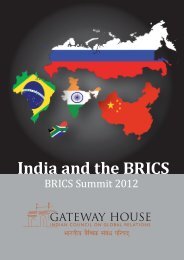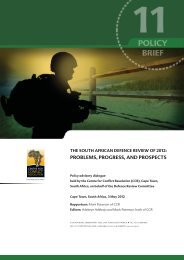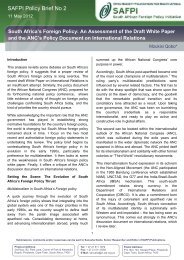Africa quarterly special on emerging powers.pdf - SAFPI
Africa quarterly special on emerging powers.pdf - SAFPI
Africa quarterly special on emerging powers.pdf - SAFPI
- No tags were found...
Create successful ePaper yourself
Turn your PDF publications into a flip-book with our unique Google optimized e-Paper software.
P A R A D I G M S H I F Tthe same type of countries, and we have much to learn fromthis regi<strong>on</strong> than from Europe or anywhere else” [Reuters,2010]. There is some truth in this although South East Asiahas some countries with high per capita incomes. If <strong>on</strong>e c<strong>on</strong>sidersthe average GDP real growth rate for South East Asia,it was 5 percent between 2000 and 2005, while it was 4.4 percentfor <str<strong>on</strong>g>Africa</str<strong>on</strong>g>. While the per capita GDP for Singapore in2005 was $20,000, the figures for Cambodia, Laos, Myanmarand Timor-Leste were less than $500. In <str<strong>on</strong>g>Africa</str<strong>on</strong>g>, thecorresp<strong>on</strong>ding figures for the same year showed that whilecountries like Equatorial Guinea had a per capita GDP of$13,410, half the Sub-Saharan states had GDP per capita ofless than $500 [UNDP, 2007]. Many South East Asian countrieshave faced socio-political problems typical to ThirdWorld nati<strong>on</strong>s and are now transiting to their own forms ofdemocracy just as <str<strong>on</strong>g>Africa</str<strong>on</strong>g>n states are trying to do. These stateshave also known war and c<strong>on</strong>flict and have faced theproblem of re-building their ec<strong>on</strong>omies. <str<strong>on</strong>g>Africa</str<strong>on</strong>g>n countriescan, therefore, relate to these countries in a way that theycannot with the major <strong>powers</strong> or even China.However, South East Asian nati<strong>on</strong>s do not have much ofa history of investing abroad, particularly outside the regi<strong>on</strong>.Transacti<strong>on</strong> and informati<strong>on</strong> costs are higher wheninvesting in <str<strong>on</strong>g>Africa</str<strong>on</strong>g> than in other Asian ec<strong>on</strong>omies and bothhost and home-country regulatory frameworks often imposec<strong>on</strong>straints. Only Singapore,Malaysia and Ind<strong>on</strong>esia began toinvest in <str<strong>on</strong>g>Africa</str<strong>on</strong>g> prior to this centuryand even then the investment waslimited. However, driven by soaringcommodity prices, FDI in naturalresources in <str<strong>on</strong>g>Africa</str<strong>on</strong>g> showed ac<strong>on</strong>siderable increase from 2005.Investment was, however, directedto <strong>on</strong>ly a limited number ofcountries.<str<strong>on</strong>g>Africa</str<strong>on</strong>g>n countries, <strong>on</strong> the other hand, are actively seekinginvestment from this regi<strong>on</strong>, which has several transiti<strong>on</strong>alec<strong>on</strong>omies with good investment potential as well asexpertise in commodity producti<strong>on</strong> like palm oil, rice andrubber. According to BJR Itoua, C<strong>on</strong>go’s Energy Minister,“It is not an <str<strong>on</strong>g>Africa</str<strong>on</strong>g> that needs humanitarian c<strong>on</strong>siderati<strong>on</strong> orpity, it is an <str<strong>on</strong>g>Africa</str<strong>on</strong>g> that needs investment and partnership”[Reuters, 2010]. In pursuit of mutual benefits, therefore, thefirst <str<strong>on</strong>g>Africa</str<strong>on</strong>g>-South East Asia Business Forum was organised inSingapore in April 2010 with the aim of bringing togetherbusinessmen, policy makers and investors from both regi<strong>on</strong>sto explore business prospects.Firms of South East Asia were urged to invest in theupgrade of airports, seaports, transportati<strong>on</strong> infrastructure,real estate, food processing, mining and energy. Given thatthe regi<strong>on</strong>’s average growth was str<strong>on</strong>g at 5.6 percent in 2010,it was better placed to invest than the U.S. and Europe. Therewere dividends from this forum: Temasek, an aut<strong>on</strong>omouswealth fund of Singapore commanding around $122 billi<strong>on</strong>,Malaysian transnati<strong>on</strong>alcorporati<strong>on</strong>s (TNCs) havebeen active in variousparts of <str<strong>on</strong>g>Africa</str<strong>on</strong>g> and insectors of the ec<strong>on</strong>omyother than hydrocarb<strong>on</strong>sis all set to invest in <str<strong>on</strong>g>Africa</str<strong>on</strong>g>; Olam, a well knowncommodities firm, has agreed to purchase <strong>on</strong>e of the threelarge wheat millers of Nigeria for $107.6 milli<strong>on</strong>. SingaporeTelecommunicati<strong>on</strong>s, too, will enter the <str<strong>on</strong>g>Africa</str<strong>on</strong>g>n marketthrough Bharti Airtel’s recent purchase of Kuwaititelecommunicati<strong>on</strong> company Zain’s <str<strong>on</strong>g>Africa</str<strong>on</strong>g>n assets. In theaftermath of the Forum, an <str<strong>on</strong>g>Africa</str<strong>on</strong>g>-South East Asia Chamberof Commerce has also been set up [Borden, 2011].At the bilateral level, Malaysia is the foremost country toseek relati<strong>on</strong>s with <str<strong>on</strong>g>Africa</str<strong>on</strong>g>n states. Malaysia’s trade with <str<strong>on</strong>g>Africa</str<strong>on</strong>g>increased from RM4.8 billi<strong>on</strong> (US$1=RM380) in 2001 toRM25 billi<strong>on</strong> in 2010 [Borneo Post, 2011]. According toMaTrade (Malaysia External Trade Development Company),bilateral trade increased 51 percent in 2010 over 2009 toRM17.99 billi<strong>on</strong>. Malaysia’s top trading partners in <str<strong>on</strong>g>Africa</str<strong>on</strong>g>are Egypt, South <str<strong>on</strong>g>Africa</str<strong>on</strong>g>, Benin, Togo, Djibouti, Algeria,Ghana, Nigeria, Mauritius and Tanzania. Palm oil was themajor export and petroleum the major import. In fact,Malaysia has encouraged bilateral relati<strong>on</strong>s through itsLangkawi Internati<strong>on</strong>al Dialogue (LID) initiative, establishedin 1995, which seeks to strengthen ties with <str<strong>on</strong>g>Africa</str<strong>on</strong>g>n andCaribbean countries. Here, ideas <strong>on</strong> trade, development,investment and even topics like religious extremism areexchanged. The initiative is underlined by the c<strong>on</strong>cept of‘Smart Partnership’, the brainchild of Prime MinisterMahathir Mohamad.As part of the Smart PartnershipDialogue, the Southern <str<strong>on</strong>g>Africa</str<strong>on</strong>g>nInternati<strong>on</strong>al Dialogue (SAID) wasset up in 1995 to enhance relati<strong>on</strong>snot <strong>on</strong>ly with South <str<strong>on</strong>g>Africa</str<strong>on</strong>g> but othercountries in the regi<strong>on</strong> likeBotswana, Mozambique andNamibia. SAID is a follow-up andcounterpart of LID, and it isadvertised as a potential growth area and hotbed forinter-regi<strong>on</strong>al trade and investment with particular focus <strong>on</strong>blocs like the COMESA and SADC [Aliyn, 2011]. Inadditi<strong>on</strong>, a Malaysia-<str<strong>on</strong>g>Africa</str<strong>on</strong>g> Business Forum (MABF) has alsobeen formed recently with its first meeting being held inJune 2011 <strong>on</strong> the sidelines of the LID meet at Putrajaya. Theinaugural theme was ‘Exploring New Dimensi<strong>on</strong>s’.At the meet, <str<strong>on</strong>g>Africa</str<strong>on</strong>g> was represented by 177 delegates from27 states, highlighting the importance now being paid toMalaysia. What is interesting is that the talks focused not <strong>on</strong>ly<strong>on</strong> ec<strong>on</strong>omic but political and social issues, including aneducati<strong>on</strong>al exchange programme and an internshipprogramme for <str<strong>on</strong>g>Africa</str<strong>on</strong>g>n students in Malaysian educati<strong>on</strong>alinstituti<strong>on</strong>s through which <str<strong>on</strong>g>Africa</str<strong>on</strong>g>n students already inMalaysia could familiarise themselves with the local culture.It should be noted that there are about 21,000 <str<strong>on</strong>g>Africa</str<strong>on</strong>g>n studentscurrently studying in Malaysia: the ‘soft’ power diplomacy atdisplay here is similar to that of the <strong>emerging</strong> <strong>powers</strong>. Itshould also be menti<strong>on</strong>ed that ASEAN is not part of MABF,which is Malaysia’s own initiative.36August 2011-January 2012





